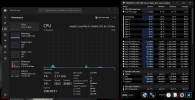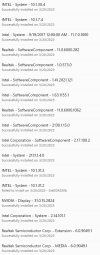Timur Born
Well-Known Member
That and the P-core clocks reading as 55/60/60/60/60/59/59/59 while turbo max restrict them to 60/60/59/58/57/56/55/55. At no time does the CPU concurrently clock 4 cores to 60x + 3 cores to 59x, so the HWinfo readings are way off. I assume that these are the last values before entering C6 state, though, so maybe this is why it shows higher concurrent clocks than possible (especially with no intermediate being C1E available).


